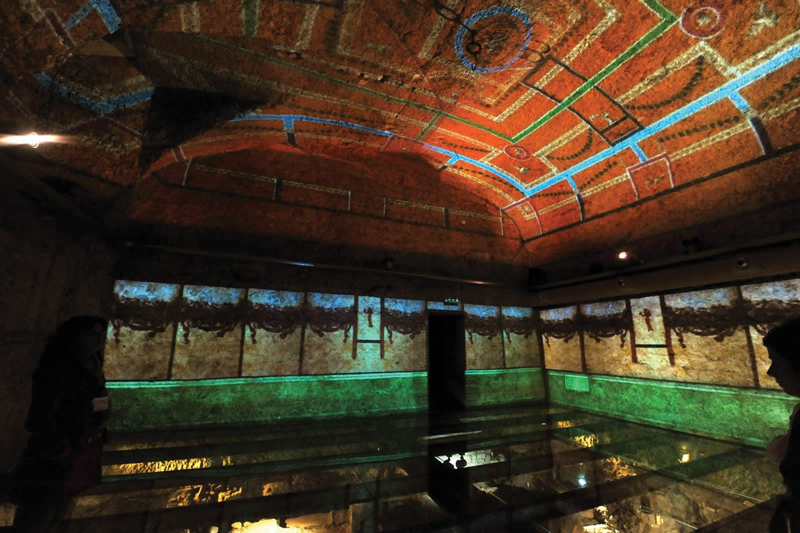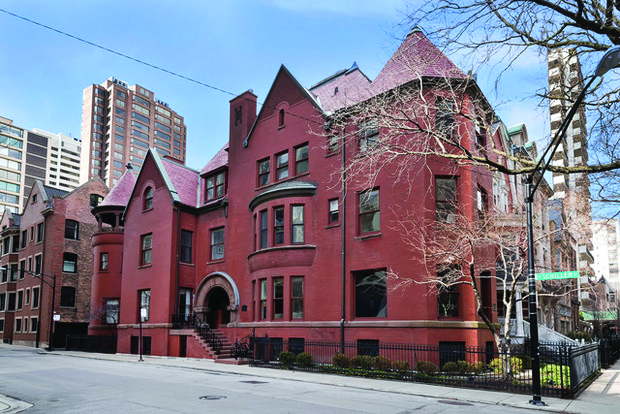Someplace old is new again: the latest in Paris & Rome
In our 10 years together, “Been There, HAVEN’T Done That”

(Pictured above: Palazzo Valentini Roman House Tour)
has traveled to unknown sites in undiscovered cities and towns around the world. Let’s revisit two of the most well-known cities that have become so overcrowded that you often have to wait on a line for their “Skip the Line” tours and then on line again for security – which only presidents and popes can skip. Let’s revisit two of my favorite cities – Paris and Rome – which I just revisited recently.
While I’ve written many times about off-the-beaten track sites in Paris and Rome that are equally as fascinating as the most famous – but without the lines –there’s yet another reason to visit both capital cities if you haven’t been there in a few years. New fantastic sites – yet to be discovered even by natives — are constantly opening.
Paris and Rome together in the same column? What do they have in common?
Both have a “Pantheon.” Rome’s Pantheon is the remarkably preserved Ancient Roman temple with a hole at the top of its gigantic dome. And Paris’ Pantheon has many holes in the ground. It’s the burial place of honor for the not-so-rich but very famous: authors: philosophers, scientists and national heroes – Paris’ Westminster Abbey.
Both Paris and Rome were “Nothing Burgs” – (that’s the urban equivalent of “Nothing Burger”) until the mid-19th century. Paris was still a medieval city with alleys instead of the wide tree-lined avenues we now know — until Napoleon III hired Baron Haussmann to superimpose the elegant city we know today. Back then Rome was a backwater with a population of 200,000 – not the 4,000,000 of today. It was only when Rome was made the capital of a united Italy in 1870 that it started growing into the Rome of today. And, yes, 2020 is the 150th Anniversary of Rome as capital of Italy.
Paris wasn’t really known for “cutting-edge” modern architecture until recently. While Paris still laments the garish Montparnasse Tower — the 1970’s skyscraper looming over the Luxembourg Gardens – dramatic new 21st-century architecture has been rising all over the city. Much of the new spellbinding architecture houses exciting new cultural venues. And these new buildings blend in with Paris’ innate historic elegance.
Opening within the past few years is my favorite — Frank Gehry’s sensational “Foundation Louis Vuitton” in the Bois de Boulogne. If you thought Gehry’s masterpiece was his museum in Bilbao, Spain – wait until you see his latest Paris museum. (If you’re a Gehry fan, visit his (1994) pre-Bilbao “Cinémathèque Française” – formerly the “American Center in Paris.”)
Like the Louvre and Musee d’Orsay, the Vuitton Foundation is a museum holding terrific temporary exhibitions. Unlike the Louvre and Musee d’Orsay, the Vuitton Foundation holds two blockbuster exhibitions simultaneously. Last year I attended its two concurrent exhibitions on two great 20th-century artists — American Jean-Michel Basquiat (marking the 30th anniversary of his death) and Egon Schiele (marking the 100th anniversary of Schiele’s death from the Spanish Flu).
Paris corrected another 1970s architectural mistake – the underground Les Halles’ (mall) inward folding architectural eyesore. Two years ago the “Grand Canopee” replaced it. The Grand Canopee is a daring, dazzling undulating glass and gold metal roof floating above acres of underground stores, restaurants, and cinemas. It’s the world’s largest and most stupendous umbrella – replacing seedy with exciting.
Just a few years ago Paris also corrected yet another 1960s and 70s eyesore. It turned the busy highway bordering the Seine into a two-mile park with gardens and even beaches – the “Berges de Seine.” After all, we can thank Paris for New York’s Highline – which copied Paris’ older and far longer Promenade Plantee linking the Place Bastille with the Parc de Vincennes. (And unlike the High Line, the Promenade Plantee has markets and stores in its viaducts’ archways below.)
It’s not enough that Paris already has two opera houses — it now has the world’s most dazzling state of the art (actually, “state of the music”) concert hall — the new “Philharmonie de Paris” by “starchitect” Jean Nouvelle. It’s in North Paris’ Parc de la Villette — an area that 50 years ago housed abattoirs – and is now home to a huge science museum, music museum, and 13 gardens. And like Oslo’s modern opera house — during intermission you can stroll its roof for some of the best views of Paris.
Recently opened is a museum dedicated to another art – the art of the couturier – the new Yves St. Laurent Museum, which is ensconced in Yves’ former showroom and office. While I’m not a fashion maven — I was fascinated by Yves St. Laurent literally treating couturier as an art — displaying his Mondrian dresses from 1969. Speaking of Mondrian, I was lucky to attend the opening of the exhibition, “Figurative Mondrian,” at another great small museum, the Musee Marmottan. This is not the abstract Mondrian of squares of primary colors and lines – exhibited on the Yves St. Laurent mannequins. This “Figurative” is the realistic style in Mondrian’s earlier paintings –– some even done in Impressionist style. (It closes January 2020.)
Within sight of Les Halles the round old abandoned 18th-century Bourse de Commerce (renovated in the 19th century) is again being renovated by magnate Francois Pinault and will open in 2020 as Paris’ latest modern art museum. This will be the sister museum to Pinault’s Punta della Dogana — the new modern art museum in Venice’s old abandoned 17th century customs building. The Pinault Paris will be joining two other world-class Paris modern art museums — the Pompidou Center (National Museum of Modern Art) and the City Museum of Modern Art in the Art Deco masterpiece – the Palais de Tokyo — a leftover from the 1937 World’s Fair.
Reopening in 2020 is my favorite city museum in the world – Paris’ “Carnavalet Museum.” It’s more than just a history museum housed in two elegant 17th century Marais mansions. It’s also a design museum with authentic period rooms from the 17th century through the early 20th century. And if you love French Formal Gardens – Surprise! – there’s an exquisite one in the interior courtyard.
Also reopening in 2020 is Paris’ expanded “Musee Cluny” – the Museum of the Middle Ages – which is partially housed in a late Gothic mansion. Adjoining the Gothic mansion is the brand new modern wing with a roofline echoing the angles of another roofline of its even older building – the almost perfectly preserved Ancient Roman baths.
Another landmark from Haussmann’s Paris that’s being restored – also to be completed in 2020 — is my favorite Parisian hotel – the Intercontinental Paris le Grand Hotel — so close to the Opera Garnier you could hear the soprano hitting a high C – that is if you can also hear dog whistles. I was a guest with my parents back in the “Mod 1970s” when the hotel’s lobby was decorated with plastic furniture sporting orange cushions. The almost total renovation decades ago – restoring it to its 1862 splendor — was perhaps the best I have ever seen. And what could be better than having breakfast every morning in the Grand Hotel’s world famous Café de la Paix – with its original plush Second Empire décor. (The only orange you’ll see here is freshly-squeezed orange juice.)
Scheduled to open January, 2020 is a new museum in one of the most beautiful squares in the world – the Place de la Concorde. In one of the square’s two identical buildings – the new museum forms one-half of the square’s 18th century elegant architectural backdrop. (The other twin building being the deluxe Hotel de Crillon.) The upcoming museum twin is in the Hotel de la Marine (in this case not a hotel accommodating guests) – which was the former Department of the Navy designed by the Versailles architect, Gabriel. It’s the “Museum of 18th Century Life” – appropriately displayed in luxurious 18th-century rooms never before seen by the public. And following a popular new trend – the Museum of 18th Century Life” will take you on a trip back to the 18th century via 21st century technology –“Virtual Reality.”
21st century “Virtual Reality” literally takes you back to the day of the Liberation of Paris, August 25th 1944 in the just opened Museum of the Liberation of Paris. The timing of the museum’s opening was “virtually” the exact day of its 75th anniversary — August 25th 2019. The museum’s location exemplifies “reality” – it’s in the basement where the liberation actually started – its command headquarters. You can’t get more real than that. If that sounds a bit confusing, it’s not – a “Virtual Reality” soldier takes you on a guided tour of the basement – showing you the actual happenings on that fateful day.
21st-century “Virtual Reality” takes you back seventy-five years to August 25th 1944 to the Liberation of Paris in the just-opened Museum of the Liberation of Paris which opened on the in the building where it actually started – in the basement — where
Now let’s go from what’s new in Paris to what’s “new” in Rome — Ancient Rome. No, that’s not an oxymoron. Just as new sites are added to Paris’ elegant streets, new sites are added below Rome’s ancient streets – new excavations are constantly being discovered and are opening for sightseeing at a record pace. In Paris, the “layered look” is usually a fashion statement. In Rome, it’s archaeology. Many new finds are joining my two favorite buildings with Rome’s “layered look” — history piled on top of history — the Casa Romane di Celio – twenty Roman homes found under the church of Saints Giovanni and Paolo. Another church, San Clemente, is a 12th-century church built over a 4th-century Early Christian church — built over an Ancient Roman Mithras that’s real bull — a cult of the worship of sacred bull slaughter.
In the rear garden of the Barberini Palace (the wonderful National Gallery of Ancient art with paintings from Holbein to Caravaggio) was discovered another Ancient Roman Mithras – now open to the public. (The garden — unknown to most tourists and even many natives — is a formal garden, which overlooks the Bernini Fountain in Piazza Barberini.)
Just opened this year on Rome’s Palatine Hill is the Domus Transitoria, Nero’s summer palace. Also recently opened for the first time in 2000 years is the enclosed Domitian’s Ramp, connecting the Roman Forum with Palatine Hill, in which the Emperor could ride, sheltered and assassin-safe on horseback.
In fact, with every extension of the Rome Metro – its latest Ancient Roman excavations reveal many artistic artifacts. That’s why the C extension – which opens next year – took so long. Archaeologists have to examine all the dirt. Let’s get the dirt on why finishing New York’s Second Avenue Subway is taking decades. Maybe American archaeologists are digging up secrets of New York City’s illustrious past – Rheingold beer cans and white wall tires?
Rome even discovered a trick to make Ancient Rome come alive with 21st-century technology – “Virtual Reality.” Virtual Reality has become a Rome reality – a phenomenon that’s quickly becoming a big tourist draw. In our September/October issue, Jax Fax’s Publisher, Doug Cooke, promotes Virtual Reality, as a sales tool. Rome and I promote Virtual Reality as a sightseeing tool, too.
Not long ago under a Renaissance building the Palazzo Valentini (overlooking the Forum of Trajan) Ancient Roman houses were discovered and excavated – one even with it’s own luxurious private bath. If Disney did Ancient Rome – this would be it. The Ancient Roman Rooms — complete with mosaicked floors and frescoed walls are visible under transparent glass walkways that become illuminated as you walk toward them — accompanied with an explanatory soundtrack. And then — like magic – the lifelike Ancient Roman rendering of the room rising from the ground to the ceiling — projected on its ruined walls. And there you are back in time – Ancient Roman time – without having to use a heavy Ancient Roman sundial. Rome wasn’t built in a day – but Ancient Rome grows around you in seconds.
My friend and Rome expert – creator of iJourneys (Rome audio guides), Elyse Weiner, compared 21st century Rome Virtual Reality to 20th century guidebooks in which you overlay an artist’s rendering of the Ancient Roman building over a photo of its 20th century ruin.
Ancient Roman Virtual Reality is spreading like wildfire – similar to the wildfire that Nero fiddled to while Rome burned. In fact, Nero’s newly opened Palantine summer summer palace – the Domus Transitoria opened with Virtual Reality last April. It joins other Virtual Reality presentations already on Palatine Hill – the frescoed and mosaicked rooms of Domus Augutus (home of Emperor Augustus) and Casa di Livia (Augustus’ wife).
I remember the spectacle of seeing Aida at the Baths of Caracalla on my first trip to Rome. Now the spectacle of Virtual Realty makes the Baths of Caracalla memorable every day, all day long. Even today I get excited whenever I see the chariot race in the movie Ben Hur . Visit the Circus Maximus and you can see a chariot race all day long – where it actually took place in the movie. (Surprisingly, none of the excavations’ Virtual Realities had a line – even in high season.)
My favorite Virtual Reality underground site is the massive Domus Aurea – Emperor Nero’s main palace directly across the street from the Colosseum. This Virtual Reality brings the palace, with its hundreds of rooms, to life and “to light” – taking us from underground to the bright Roman sun of the first century AD. You even see the hole in the ceiling where you can imagine the great Renaissance artist Raphael sneaking in to copy the grotto’s fresco patterns — which became the “grotesque” designs in the Vatican’s Raphael Loggia and in Catherine the Great’s exact copy in the Hermitage.
Domus Aurea’s neighbor, the Colosseum, just got Virtual Reality but for that too well known site – there’s a virtual line.
And if you’re getting hungry after a day of visiting Ancient Roman excavations – you can also dine in them. Two excellent restaurants are built on the ruins of the Theater of Pompey – Pancrazio and Costanza — and they’re both off Campo dei Fiori – Rome’s market square during the day.
I hope you’re now seriously considering visiting and dining in Rome’s excavations – old and newly discovered. And if you want to sleep on it — or rather “sleep over it” – you can actually sleep over excavations, too. The elegant and glamorous Hotel Palazzo Naiadi is built over the ruins of the massive Baths of Diocletian (at Piazza della Republica) – which are glamorously preserved in the hotel’s elegant basement. Speaking of glamorous, last May I saw the beautiful Sophia Loren in the lobby.
Yes, in Rome – hotels can become museums. A few blocks from Piazza Republica is the Hotel Mediterrraneo. If you love the Art Deco hotels of South Beach – imagine a much taller version in the heart of Rome. Besides the gleaming Art Deco furniture and mosaics in the lobby and the all the public rooms – the recently renovated bedrooms are also furnished in Art Deco.
If you love dining at the Hassler Hotel’s restaurant with its spectacular view over Rome and Rome’s well-known and crowded shopping street, Via Condotti – try another hotel with fine dining and an equally great view – the Atlante Star – just across the Tiber. The food at its Etoile gourmet restaurant is heaven and the view is as close to heaven as you can get in Rome — St. Peter’s and the Vatican. The Atlante Star is in the upscale residential Prati neighborhood with its un-crowded excellent shopping street – Via Cola di Rienzo, which even has a branch of Tiffany.
And if you like luxury without paying Via Condotti prices, fly Norwegian Air’s Premium Class with flights from the US to Paris and Rome. While I love Ancient Rome – I like new planes. And Norwegian flies Boeing’s new 787 Dreamliners to Rome and Paris.





